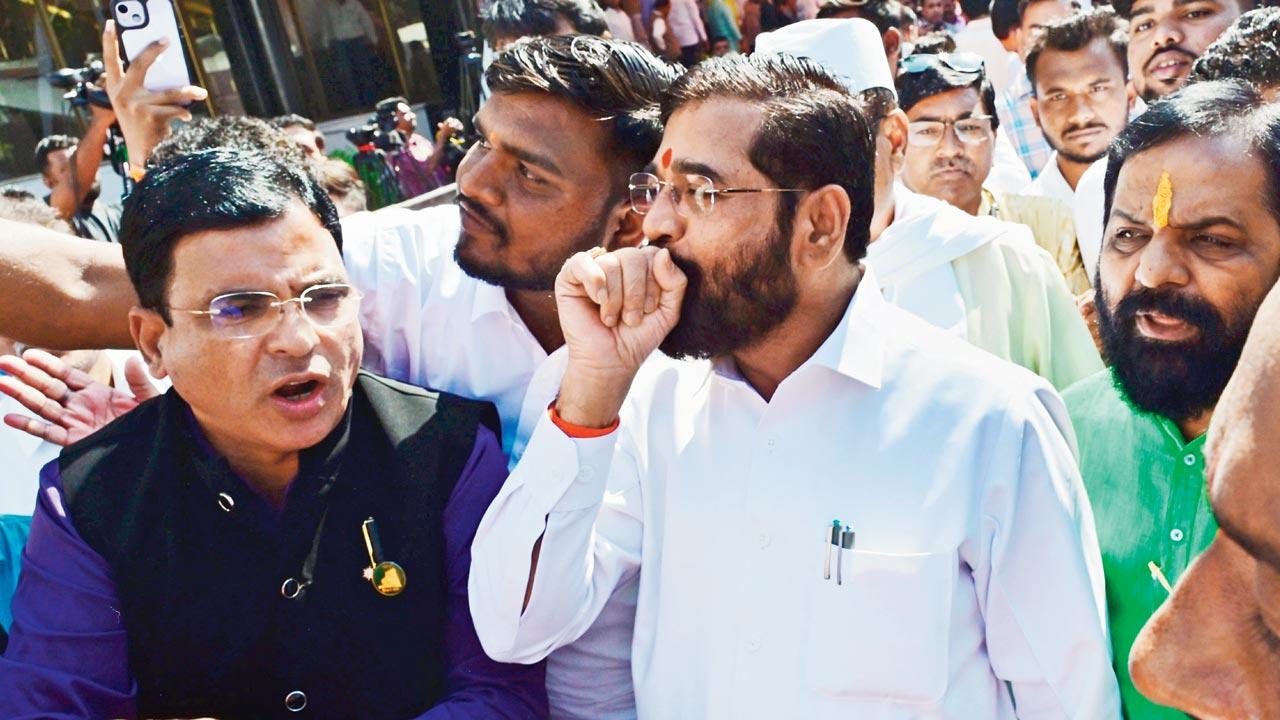If deputy CM speaks up against three-language policy introduced by his own government, it will cause the Mahayuti alliance to crack; but if he stays mum, he risks alienating Sena’s core base of Marathi speakers

Eknath Shinde, Shiv Sena chief and deputy chief minister. File pic/Shadab Khan
 Shiv Sena chief and Deputy Chief Minister Eknath Shinde has maintained silence on the recent row over teaching schoolchildren Hindi under the three-language education format. It looks like he is treading cautiously, for two reasons — one, he is part of the Mahayuti, and any move to oppose the policy could strain his alliance with the Bharatiya Janata Party (BJP) and, secondly, supporting the move comes with the risk of alienating his core voter base, the Marathi-speaking population. This simply means, whatever stance Shinde takes, it will certainly come at a cost for him and his party.
Shiv Sena chief and Deputy Chief Minister Eknath Shinde has maintained silence on the recent row over teaching schoolchildren Hindi under the three-language education format. It looks like he is treading cautiously, for two reasons — one, he is part of the Mahayuti, and any move to oppose the policy could strain his alliance with the Bharatiya Janata Party (BJP) and, secondly, supporting the move comes with the risk of alienating his core voter base, the Marathi-speaking population. This simply means, whatever stance Shinde takes, it will certainly come at a cost for him and his party.
The ‘Sarkari’ decision allows schools to introduce three languages in the syllabus. Though Hindi has not been made mandatory, the language finding a place in the curriculum is being seen by critics as a veiled backdoor push into Maharashtra’s classrooms. Some political parties also see the move as an attempt to dilute the prominence of Marathi in its own state.
While prominent political leaders such as Chief Minister Devendra Fadnavis have defended the three-language policy, stating that the government has not made Hindi mandatory, as per the National Education Policy (NEP) 2020, two of the three languages should be native to India, and a regional tongue is a must. This means students from Std I to V across the state will have to take up Marathi, English —an international language of communication — and Hindi or any other Indian state language.
The language controversy began in April and has snowballed into a bigger political debate. Raj Thackeray, chief of the Maharashtra Navnirman Sena (MNS), and his estranged cousin Uddhav, who heads the Shiv Sena (UBT), have opposed the decision, claiming it is an attempt to sideline Marathi and reduce its dominance. But, Shinde, so far, has not indicated whether he is in support or against the decision.
One should not forget that for Shinde, and leaders from his camp, their political rise has been rooted in the Marathi ideology, a legacy inherited from the undivided Shiv Sena.
Marathi votes have been the focus of Uddhav, Raj and Shinde. Especially in areas like Lalbaug, Parel, Dadar, Parle, Bhandup, Vikhroli, Kandivli-Borivli (Charkop, Gorai, Magathane), the community votes give these parties an edge over their rivals. For Uddhav, it is an emotional connection. Similarly, for Raj this is probably the last chance for a revival — if it has to happen at all — and for Shinde to prove that he is more than a rebel.
No wonder, ahead of the BMC elections scheduled for later this year, where the community votes will be a decisive factor, Raj and Uddhav are leaving no stone unturned to latch on to the language row to score brownie points.
While the issue has put the focus back on both Raj and Uddhav, for Shinde, staying mum for long will ideally not be a good thing to do. In fact, at some point, Shinde and his party leaders will have to express their views on the issue to clear the ambiguity and keep their vote bank intact.
But, the catch is that the policy in question was introduced by School Education Minister Dada Bhuse, a close aide of Shinde and a leader of his Shiv Sena faction.
Aware that supporting or opposing the policy would lead to weakening of Shinde’s grip either within the alliance or on Marathi speakers, those close to ‘Bhai’, as Shinde is fondly referred by his followers, are making desperate efforts to get Raj on their side before the crucial BMC elections and avoid division of Marathi votes and damage to Mahayuti.
Last year, during the Assembly polls, the UBT camp won 20 Assembly seats, of which 10 were from Mumbai. On other hand, the Shinde faction bagged 57 Assembly seats in Maharashtra, of which six MLAs are from Mumbai.
As there was tussle between two Sena factions on who is the real one, the Shinde camp, after the state Assembly results, started claiming that the people of Maharashtra had endorsed them as the real Sena, as they won 57 seats, far more in number than 20 seats won by the UBT camp. But, many in political corridors believe that the game is far from over as it remains to be seen who will capture the final fort – Mumbai. The BMC elections results will decide whether Sena, which has always got its power from Mumbai, is with Shinde or Uddhav.
The undivided Shiv Sena in 2017 had bagged 84 seats in the BMC, two more than the BJP. For 25 years Sena-BJP alliance ruled the BMC. But, in 2017, Sena-BJP contested separately. The BJP won 82 seats, a significant improvement in its tally of 51 corporators in 2012.
However, in 2022, Shinde engineered a split in the party and now there are two Sena factions, one headed by Shinde and other by late Balasaheb Thackeray’s son Uddhav. In 1966, Balasheb had formed Shiv Sena to fight against injustice meted out to ‘Sons of Soil’.
The local body election will be the first civic polls after the split in Sena. Thus, for Shinde, taking control of the 227 member-strong BMC House is not just about administrative power, but about delivering the ultimate proof that his faction is the true political and ideological inheritor of Bal Thackeray’s legacy. Likewise, for Uddhav, it is not just about retaining the BMC that it has been ruling for over two decades, but staying relevant in the fight for legacy.
No wonder, on June 19, the 59th foundation day of Shiv Sena, both faction leaders while addressing their respective party workers asked its rank and file not to lower the guard and stay alert for the Mumbai’s election, as this will by and large decide the fate of both parties.
Of the 84 corporators elected on the Shiv Sena (undivided) symbol, over 45 of them quit the Uddhav camp to join the Shinde Sena. In fact, Shinde claims 50 of them have joined him, a clear indication that old-time sainiks are shifting loyalties. Had the Hindi row not come to fore, at this crucial junction (ahead of the BMC polls), Shinde and his party would have certainly given a tough competition to UBT candidates.
But, now Shinde has no choice but to face the situation. At a crossroads, he and his camp will find navigating the language row tricky since it is not limited to a policy matter or education curriculum, but it is all about political identity and ideology.
Sanjeev Shivadekar is political editor, mid-day. He tweets @SanjeevScribe
Send your feedback to mailbag@mid-day.com
The views expressed in this column are the individual’s and don’t represent those of the paper
 Subscribe today by clicking the link and stay updated with the latest news!" Click here!
Subscribe today by clicking the link and stay updated with the latest news!" Click here!










